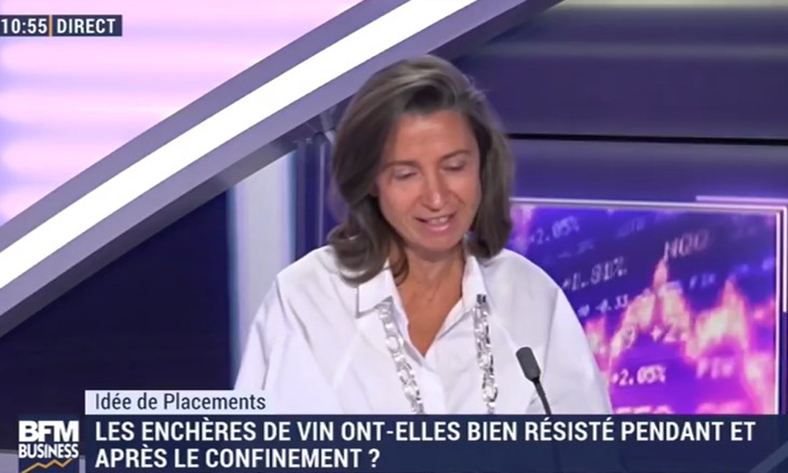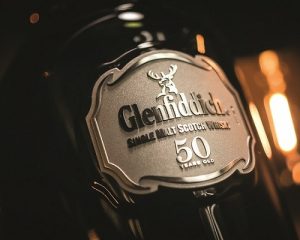
Every month, Angélique is invited by Cédric Decoeur and Guillaume Sommerer onto the Intégrale Placements segment of the BFM Business programme. Here, she discusses the latest trends in the fine wine market from an investment angle.
What has the first semester looked like for iDealwine? Have wine auctions resisted well to the changes brought by lockdown and the reopening we’ve seen since?
This period has been a unique one in the world of auctions, as is the case for most industries. The results we’ve had at iDealwine have indeed been affected by the coronavirus crisis. Our auctions saw a slight decrease of -2% at the end of June, which was luckily compensated by a successful run of fixed price sales.
There are three things to point out here:
- The auction part of our activity was growing strongly at the end of February 2020 (+31%). Then the effects of the lockdown were felt heavily, not due to any drop in interest on the part of the wine community, but more because of a drop in our stocks. Our expertise lab was closed and there was no way to collect bottles from private sellers. And this lasted for two long months. Since the 11th May, business has managed to pick up again, but the effects of those weeks of lockdown are plain to see: -2% at the end of June.
- The model of the online auction has been fully legitimised during this period with wine enthusiasts continuing to covet our selections. We saw an explosion of +51% in traffic to our site, and are now experiencing sales of around 80% for each auction. Sellers are getting their bottles to bidders far quicker.
- Since the range of wines available at auction reduced somewhat, wine lovers diversified their purchases, including more interest in our fixed price sales. There was an increase of +75% in volume and +64% in value sold.
Have you noticed any changes in what is being bought at auction? Or in the clients who are buying?
Crises such as this one always serve to reveal important trends. Our French buyers reinforced their position, representing 55% of total revenue, with sales in France increasing by 10% in the first semester. At the same time, Asia – our top export zone – has turned out to be a little bit shaky (-11%) for various reasons to do with the pandemic and the economy at large. Sales to the US have also been impacted, particularly when the virus added to the question of import taxes. We have seen a slight decrease in the figures for this country. However, the figures for Europe have been a nice surprise, a zone that has been very dynamic overall in the first semester (+33%).
So have you noticed an evolution in the kinds of wine being sold?
The percentage of Bordeaux grands crus being bought at auction is continuing its decline. Even if it remains in first place in terms of volume, representing 36%, Burgundy has taken over in value. 35% of our sales in value were bottles from Burgundy across the first semester, compared to 34% for Bordeaux.
These traditional regions still make up the basis for auction sales, though?
Yes, but overall we have observed a decline for both of them. Bordeaux and Burgundy have historically been leaders in the market, but we’ve seen their share gradually decrease over the months, with other regions gaining in interest. The Rhône is progressing in both volume and value, much like Languedoc Roussillon and non-French wines. In Champagne, the value of the wines is on the up. Nothing is set in stone but what’s notable is the speed at which this evolution is taking place. In 2017, Bordeaux made up over 50% of our sales! Buyers are seeing more and more interest in diversifying their cellar.
Nonetheless, these are the regions that have recorded the best-performing sales so far?
In the ranking of the highest-priced bottles sold in the first half of 2020, Burgundy takes up 8 places including the top spot; a 2009 Romanée-Conti sold for €16,578. Bordeaux takes up 5 places in this ranking, including a magnum of 2000 Petrus that went for €8,228. Whilst the Rhône is under-represented (just one place, the 1990 Cathelin cuvée from Jean-Louis Chave), we also find two Champagne cuvées, one Dom Pérignon and a Krug.
Do you recommend sticking to the classics then?
Not necessarily, there are already some outsiders in this year’s ranking!
Two points are revealing of current trends in the grands crus market:
- 11th place is occupied by the first vintage crafted by la Grange des Pères, a Languedoc star, which was sold for €5,035 in its 1992 vintage. A sign of things becoming more diverse, with purchases that align excellence and rarity proving to be superb investments.
- Secondly, we should note that 3 of the top 20 bottles are spirits. Two whiskies and a cognac. This isn’t a totally new phenomenon, as we’ve already seen interest in cognacs, Armagnacs and chartreuses for a long time. Interest in whisky is more recent. This is a trend to keep an eye on in the context of investment.
To finish, should we be getting our hands on some 2019 primeurs?
2019 was a challenge to taste before the primeurs campaigns, but it has revealed itself to be of high quality. The prices have seen a decrease of 18-20% in some cases, a reduction that could be slightly misleading since the prices from some properties have increased a lot in recent years. So it could be interesting to have a 2019 in your cellar, but be careful to weigh up your options. Compare these prices with good vintages that are already available. In the long term, the 2019 is likely to be a good investment, since it looks to be a fine, cellaring year.



